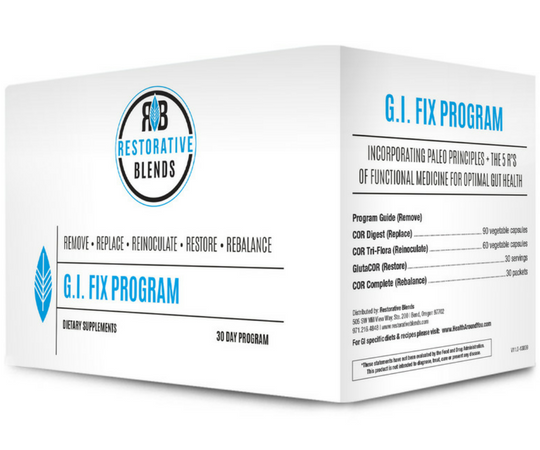
18 Aug G.I. FIX Intro and Prep
Are you ready to commit to G.I. FIX 30 Day Digestive Health program designed by Paleo Magazines “From the Doc” columnist, Dr. Jason Kremer, to experience firsthand what a health promoting whole food diet can do for you? The dietary component of this program involves an Elimination Diet following many of the Paleo principles for eliminating many of the inflammatory foods and common food allergies/sensitivities/intolerances. Perhaps you’ve been interested in giving a Paleo diet a try but you just weren’t sure where to start? Or maybe you’ve looked into other gastrointestinal specific diets (low FODMAPs, GAPS, Specific Carbohydrate) and just need a little more direction.
This program will benefit the sedentary 8 hour a day office worker to the elite level athlete and combines the benefits of a more ancestral diet with clinical-grade supplements and modern day science to back it up. This physician developed program addresses a more complete approach and is optimal for heart and cardiovascular health, gastrointestinal support and function, reducing inflammation and oxidative stress, and helps recognize and determine food sensitivities and intolerances.
Still new to a Paleo diet and want to learn more before taking the plunge? Click Here to learn more.
You can now experience the benefits of a whole foods-based ancestral diet with simple and easy to follow recipes, the appropriate support provided by clinical-grade supplements for restoring your gastrointestinal tract and build your knowledge around this way of eating and how your health and genetic make-up were meant to thrive. For those planning to try this “whole food” Paleo style diet for the first time, we recommend dedicating yourself to this plan 100% for 30 days in conjunction with the recommended supplements. Chances are, in just 30 days you’ll notice increased energy, improved body composition, fewer food cravings, enhanced digestive health and a variety of other health benefits. From there, you decide if you feel better off certain foods, your mental function and athletic performance improve, or you just have normal bowel movements for the first time in your life and want to continue to experience these improvements.
As this program also provides the benefits of a detoxification program and eliminates many of today’s common food allergens, intolerances and sensitivities, we have structured the program to work as an Elimination Diet to re-introduce a specific food or food group every 2 days. This will allow you to better determine the specific food or foods that may be leading to GI discomfort, headaches, fatigue, weight gain, brain fog, skin complaints, etc.
While the dietary component does require some planning, our 30 Day G.I. FIX program guidebook will . To make this transition even easier, you will have access to the extensive Paleo recipes found on the Health Around You website. To obtain the most optimal benefits, adding at least 20 minutes a day of walking or other continuous movement is recommended if you do not already have an exercise program. If you already have a solid workout routine or are a competitive athlete, that’s even better! For those with more moderate to strenuous activity levels, you may need to take in additional calories from carbohydrates in the form of the suggested fruits and sweet potatoes.
Before Beginning
Before getting started it is highly recommended to spend a couple of hours preparing your pantry, fridge, and home for the weeks ahead. Clean out your fridge and pantry from any tempting non-Paleo foods. Remember, to get the full potential from the 30 Day Challenge you must stick to the allowed foods 100% of the time and avoid the rest of the foods (grains, legumes, processed foods, dairy, sugars) with strict adherence. In those with food sensitivities (gluten and dairy for example) periodically reintroducing these foods will result in reintroduction of inflammation and elevate the potential immune response we are trying to diminish. The only way to truly know how certain foods are affecting your health is to remove them from your diet for a specific amount of time and monitor changes in symptoms.
Clean Out “Temptations”
This may include cleaning out any ice cream from the freezer, crackers, chips, candies, cereals, and/or other processed goods from the pantry, and cheeses, yogurts, and other non-Paleo goodies from the fridge and cupboards. Of course, this process will be different for those with non-Paleo family members or roommates; however simply ridding the house of any items that will be particularly tempting during the upcoming 30 days is strongly recommended.
Once you’ve cleaned out those temptations, go shopping to replace those temptations with health-promoting foods!
Some Staples that you’ll want to have on hand include:
Frozen fruits and veggies (you’ll be given a shopping list for fresh fruits and vegetables that you’ll need each week but it’s a great idea to stock up on frozen spinach, green beans, asparagus, berries, or any other Paleo-friendly frozen produce items that appeal to you.)
- Frozen chicken breasts, fish fillets, shrimp, roasts, salmon patties
- Nuts/seeds: almonds, pistacios, walnuts, pecans, cashews, sunflower seeds, flaxseeds, chia seeds
- Grain-free flours (almond and coconut)
- Coconut or almond milk (from the can or carton, the can varieties typically have higher calories and fewer additives)
- Organic Jerky (organic nitrite and nitrate free)
- Herbs and spices (basil, chives, cumin, garlic powder, ginger, turmeric, Italian seasoning, chili powder, curry powder, and/or other spices of choice)
- Coconut oil and olive oil (cold pressed)
- Spicy mustard, Coconut Aminos, apple cider vinegar
Other items that may come in handy include:
- Tupperware (this is a “must” if you don’t already have a good supply. Opt for glass varieties or those that are BPA free).
- Crock Pot/Slow cooker
- Blender/food processor
- George Foreman Grill
- Food scale – While this is totally optional, using a food scale for the upcoming 30 days is a great tool to help you become more aware of what a serving size looks like. Of course, on the Paleo program we really don’t obsess about portion sizes and instead focus on how you feel with certain amounts of food. However, those who truly have no idea what a healthy serving size of meat of fish actually is will benefit from a food scale by ensuring that they are eating enough protein while not overdoing it. The goal with this 30 day challenge period is to become more aware of the amount of food and the types of food that you need to function optimally! You can find these at Target and Walmart for less than $15).
In addition to cleaning out the cupboards, freezer, and pantry it may also be a good idea to supply any other places in which you tend to spend your time. This may include stocking your work space and car with healthy options like nuts, tuna packs, canned sardines, organic jerky, fruit, and vegetables (desk snacks shouldn’t be too tempting and shouldn’t be something that you can mindlessly munch on!). A cooler is a great tool to have both in the car and at work for those times when you miss a meal or need a little something to get through the day.
Planning Ahead
In the upcoming weeks, one of the best things that you can do to help you stay on track is to always be prepared. While this program was designed to give you all of the guidance necessary, planning ahead and being prepared is going to be up to you in the upcoming weeks. Some ideas to help with the planning and preparation process include:
If you find that you don’t have time to prepare meals each day, take time a few nights per week to prepare a large amount of food that you can eat throughout the week. For instance, make a large batch of chicken one night and use it over the course of the week to make chicken salad, chicken tacos, chicken fajitas, chicken soup, or any other healthy recipes you enjoy.
Prepare your meals for the next day the night before to ensure that you’re ready to go at the start of each day. Sometimes we oversleep, run out of time, or simply forget to prepare our meals in the rush of getting ready in the morning. Preparing your meals the night before will ensure that you start each day prepared and off to a healthy start. You’ll also notice that many of the dinner meals on the menu suggest making extras for leftovers for the next day’s lunch. For those with busy schedules, these leftovers should help immensely in providing atleast one meal for the following day.
Have emergency meals on hand for last minute, unexpected events. This may include making a large batch of soup and dividing it among a few tupperware containers to be frozen for those days when you just need to grab a quick and healthy Paleo meal. Another idea is to make a batch of organic chicken or beef patties to be frozen for those days when you need to grab a healthy shot of protein on the fly. Some stores such as Costco and Trader Joes are now carrying organic gluten and dairy-free sausages and meatballs that also make great options for throwing in the freezer for those emergency situations when you need to grab a quick meal or snack without straying from the Paleo plan. Packets of tuna, while shouldn’t be relied upon on a daily basis, also make a great last-minute snack or meal option (and they don’t need to be frozen!). Lastly, dehydrated sweet potatoes, squash, or other vegetables can make a great snack on the fly as well as healthy snacks for those last minute hikes or outdoor activities (it is recommended to store these items in the freezer).
Dining Out
While dining out can be a little more challenging while following this strict 30 Day Elimination diet, there are some types of restaurants that are more likely to have Paleo, dairy-free, and gluten-free options on their menus. These include:
Sushi- You can’t go wrong with sashimi and a cucumber seaweed salad. Sushi joints usually also offer meat and veggie salad option as well as meat and veggie stir fry options. Avoid soy sauce as it contains soy AND wheat. Wasabi is fine as long as it is dairy-free.
Thai Food- Most Thai food restaurants will have options catering to the Paleo lifestyle. Because coconut is perfectly fine on the Paleo diet, most curries are acceptable as long as you hold the rice. Most Thai places will also offer a simple vegetable stir fry with meat and many of their salads and soups are Paleo.
Steak houses- Pretty much every steak house offers a steak and vegetable option or salmon and veggies. If you need a little more food, appetizers such as shrimp cocktail, grilled ahi, and steamer clams are also perfectly fine. The house salad is also a good option, hold those croutons and vinegarette dressing on the side of course.
Buffets- If you have known food allergies and/or intolerances, buffets are not always a wise choice. However if the gang wants to hit the buffet and you’re along for the ride, you do have some options at most buffet style restaurants. Be sure to hit that salad bar first, loading up on the vegetables and avoiding things like croutons, cheese, and cottage cheese (sunflower seeds, beets, eggs, and all the vegetables you can handle are perfectly fine though). For meat options, stick to the grilled or baked meats and avoid anything fried and/or breaded. Green beans and other vegetables might look Paleo friendly but note these are often cooked in butter so it is advisable to ask how they are prepared before digging in. For dessert, most buffets do have fruit available so enjoy a small bowl of that if you have a sweet tooth after enjoying your dinner. If you suspect that you may have an issue with gluten, it is recommended to avoid these kinds of facilities until completing the challenge due to potential cross contamination.
Mongolian BBQ- Mongolian BBQ’s are another form of restaurant that wouldn’t be advisable for those with food allergies (primarily gluten), however for the average Paleo diner, Mongolian BBQ can be an option for dining out. Skip the noodles of course and opt for vegetables and meats instead. Make a note that imitation crab contains gluten (and a bunch of other junk) and also avoid any sauces that contain soy, BBQ, or teriyaki sauce. If you suspect that you may have an issue with gluten, it is recommended to avoid these kinds of facilities until completing the challenge due to potential cross contamination.
Traveling:
The following are examples of foods that tend to work well when traveling during this 30 Day program:
Jerky
Pepperoni Sticks
Smoked Salmon
Boiled Eggs
Raw sunflower seeds
Pistacios
Kale Chips
Seaweed Snacks
Vegetable Sticks
Tuna packs
Canned sardines, anchovies or trout
Fruit (opt for fresh over dried as dried fruit tends to be loaded with extra sugar and calories, something you don’t necessarily want while traveling).
When on the road, if you find that you need to stop for a quick bite to eat a wise choice for finding acceptable fares is to stop into a grocery store instead of bothering with fast food restaurants. All grocery stores will have fresh produce, nuts, lunch meat, and jerky (make sure to opt for the least processed lunched meats possible, preferably nitrite and nitrate-free). You can also stop by the meat counter for some cooked shrimp or smoked salmon and many grocers even carry boiled eggs in their deli section. This will give you many more options than bothering with the local McDonalds and will allow you to pick up extras if you’re going to be traveling for more than a couple of hours (of course, if you know you’re going on a long road trip it is always a good idea to pack a cooler full of healthy foods).
Please note that while it is very important to include a variety of foods in your diet over the next 30 days, you can certainly adjust the menu as necessary to meet your needs and goals. Some may find that the amount of food suggested on their meal plan is simply not enough food, or is too much. If you find that you need more food, begin by first adding more vegetables (eat all of these you want!) and then by increasing the protein intake by having slightly larger portion sizes of meat and eggs. If this still leaves you feeling unsatisfied, adding more nuts and fruit is also an option.
You’ll notice that the menu plan includes many meals that utilize leftovers from the previous meal or day. If you’re not a fan of leftovers, simply opt for some form of protein, vegetable, and healthy fat for that meal (or simply plug in another meal from the menu or a previous menu that appeals to you). You’ll notice that eggs are included in many morning meals but are rarely suggested in multiple meals throughout the day. The reason for this is because eggs tend to be a fairly common allergen for some and are a food that some will develop allergies to over time if too many are consumed on a regular basis. For this reason, we recommend enjoying those organic eggs regularly, but not getting too carried away with them by consuming them multiple times throughout the day for many days in a row. You may also notice that breakfast meats such as bacon, sausage, and ham are rotated every week on your morning menu. The goal with these meats, again, is to not eat too much from any one meat group.




Sorry, the comment form is closed at this time.